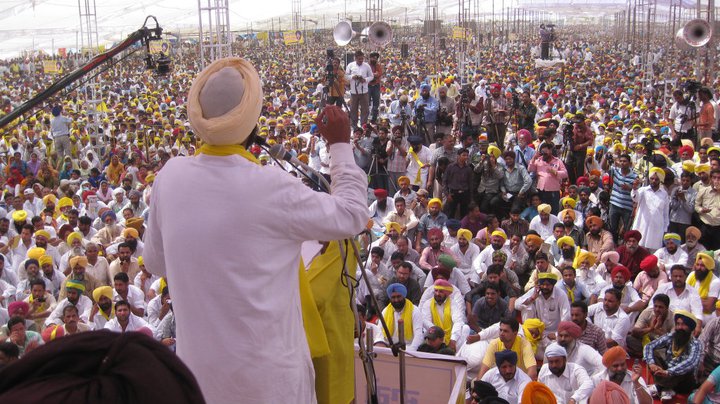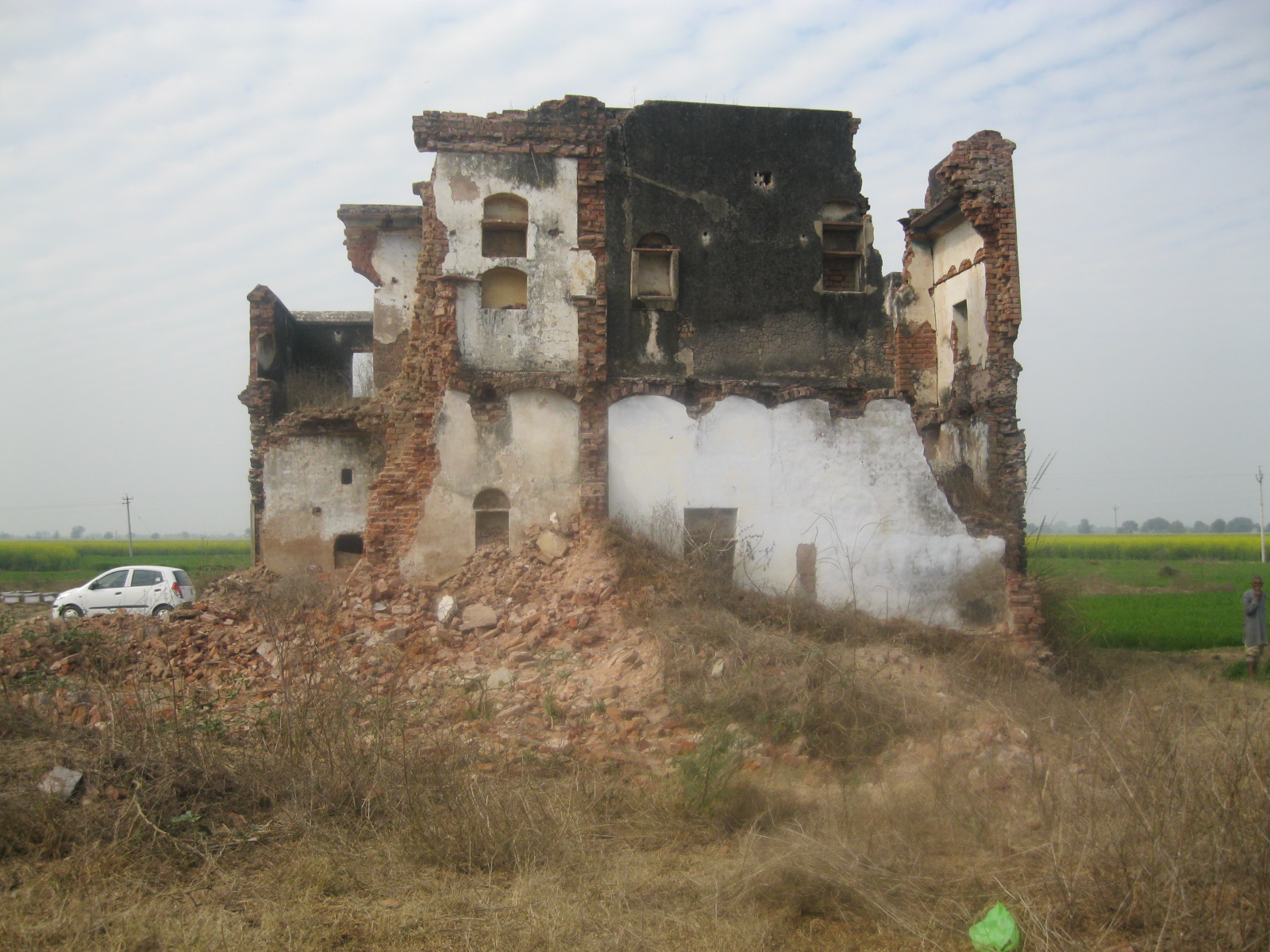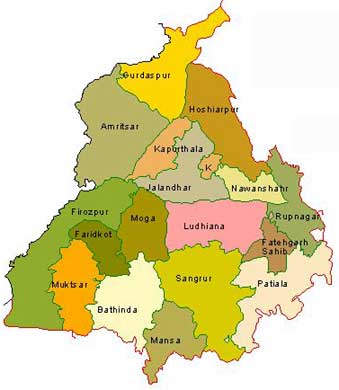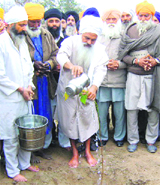
 This week, Ensaaf launched their Challenge the Darkness campaign. The aim of the campaign is to remember human rights activist Jaswant Singh Khalra and bring awareness to the mass state crimes committed in Punjab, India from 1984 to 1995. At the end of the month, Ensaaf and the Khalra Mission Organisation will participate in a series of events to remember Khalra’s abduction, torture, illegal detention, and murder. We’ll update you on these events as information comes our way.
This week, Ensaaf launched their Challenge the Darkness campaign. The aim of the campaign is to remember human rights activist Jaswant Singh Khalra and bring awareness to the mass state crimes committed in Punjab, India from 1984 to 1995. At the end of the month, Ensaaf and the Khalra Mission Organisation will participate in a series of events to remember Khalra’s abduction, torture, illegal detention, and murder. We’ll update you on these events as information comes our way.
Post-1984 memory is often forgotten and yet hundreds of thousands of human rights abuses have been documented in Punjab during the 1984 to 1995 period when the Indian government ordered counterinsurgency operations that led to the detention, torture and enforced disappearance of thousands of Sikhs. Police abducted young Sikh men on suspicion that they were involved in militancy, often in the presence of witnesses, yet later denied having them in custody. See the Human Rights Watch Photo Essay here.
Director General of Police KPS Gill expanded upon a system of rewards and incentives for police to capture and kill militants, leading to a dramatic increase in disappearances and extrajudicial executions. By the end of the “Decade of Disappearances” in 1995, security forces had disappeared or killed tens of thousands of Sikhs. In order to cover up their crimes, Punjab security forces illegally detained, tortured, and killed human rights defenders such as Jaswant Singh Khalra and Sukhwinder Singh Bhatti, as well as secretly cremated thousands of victims of extrajudicial executions. [via Ensaaf]
In September 1995, Punjab police abducted human rights defender Jaswant Singh Khalra from his home for his discovery of thousands of illegal killings and secret cremations by the Punjab police. At the end of this post, you can view two videos depicting the events leading up to and of his disappearance.
The results are in and much to no one’s surprise – Badal and his cronies won.
If you ran against the don, he sent his goons.
If your supporters were going to come out and vote, they captured the booth and made sure your supporters were turned away.
If they thought it was going to be close – they stuffed ballots and created “Sikhs” (man-pagh, pagh-man, voila! Sikh – or at least one that was eligible to vote).

If they thought you even had a chance to win, they shot off a couple of rounds in the air and had the balloting canceled and postponed.
The worst part was this happened in full view of the media and in front of the world. Are we that apathetic?
This is how the Panth’s resources are kept safe to line Badal and his cronies’ pockets. Only the Government of India (GOI) can call for the elections and only the GOI’s police can make sure they are “secure” and “safe” (for Badal to win). This is how we are kept enslaved.
I have shared my views on Manpreet Badal and the PPP in the past. I still stand by my analysis, but as the election draws nearer, the youth of Punjab are making their voices heard.
Recently Manpreet Badal has been visiting the US this month and gaining more and more popularity among the non-voting NRPs (Non-Resident Punjabis), but if this show of support can be capitalized in Punjab is yet to be seen. His campaign has had a few major hiccups recently, with supporters such as Rajya Sabha member, Varinder Singh Bajwa, being re-wooed by Punjab’s greatest snake-oil seller, Parkash Badal. This loss comes soon after Manpreet had lost the support of his former “right-hand man”, Charanjeet Brar. It has been a long few weeks.
Still amongst a large number of Punjabi youth, they are still showing their support and hope, through creating videos on youtube to help galvanize the youth.
Here is one such example, a parody of rapper Wiz Khalif’a’s celebration of his native Pittsburgh – Black and Yellow. Here the artists – Sugar Cane Records and Jogi – ask who to vote for – Chitta (the color associated with the Congress Party) or Neela (the color associated with the Akali Dal). Both are thieves, the difference only the color.

UPDATES 8/20/11 as of 12:30pm
The pardhan of the pind Gurdwara tries to state that the whole village apologizes, without giving any specificity as to the culprits or accountability for the action. One Singh in attendance will not stand for it:

Yesterday, Punjabi Radio USA spent an entire show on the issue, interviewing a member of the SGPC as well as some people that have traveled to the village and give their eye-witness testimonials

Still no news on the Tribune India (English) page. There is news on their Punjabi page as well as that of the Ajit and other Punjabi news outlets.
—————————————————-
Today we remember twenty seven years since June 1984.
We remember twenty seven years since Indira Gandhi sent the Indian Army tanks and artillery to the Darbar Sahib Complex and forty one Gurdwaras across Punjab on the shaheedpurab of Guru Arjan Dev Ji.
We remember twenty seven years since bodies lined the hot marble of the parkarma. Though Government reports indicate 493 civilian deaths and 83 army casualties, eyewitness accounts suggest the numbers were much higher since 10,000 pilgrims and 1300 workers were unable to flee the Darbar Sahib complex on this day.
We remember twenty seven years since books, manuscripts and other documents have been reported missing from the Sikh Reference Library numbering 10,534. The library which was intact on June 6th had been burnt down by June 14th. In April 2004, many of these writings, which included handwritten manuscripts were reported to be in the hands of the Union Government where they remain today.
We remember twenty seven years since the events that spurred the November 1984 pogroms and the government lead counter-insurgency in Punjab which left a generation of 25,000 missing.
We remember twenty seven years since Sikh women (and men) learned too well that coercion does not just come from tanks and artillery – that sexual violence can be a systematic and deliberate weapon of the State.
We remember twenty seven years since Punjab was left a political climate that hid the state’s impending agrarian crisis and its interrelated manifestations of farmer suicides, drug addiction and gendercide, even when reports as early as the 1985 Johl Report warned that the farming sector was faltering and the real need to diversify crops from the standard wheat-paddy rotation.
We remember the impact this had on the Sikh Diaspora, the communities New York, California and Canada, and the tireless nights many of our fathers and mothers spent out, mobilizing themselves even as recent immigrants with young daughters and sons.
We are a community that is well versed in Remembrance.
Last week marked the 63rd anniversary of the Nakba, meaning catastrophe, when a n estimated 700,000 Palestinians were displaced from their homes with the establishment of the state of Israel in 1948. I, and others, have argued elsewhere why the Palestinian struggle for freedom and self-determination is relevant for us as Sikhs, so I won’t reiterate that here (see Sikh Solidarity with Palestine statement).
n estimated 700,000 Palestinians were displaced from their homes with the establishment of the state of Israel in 1948. I, and others, have argued elsewhere why the Palestinian struggle for freedom and self-determination is relevant for us as Sikhs, so I won’t reiterate that here (see Sikh Solidarity with Palestine statement).
Every year Palestinians and their supporters commemorate the Nakba by holding demonstrations, vigils, and educational events. This year saw unprecedented resistance by Palestinians in the Middle East, who mobilized at numerous points across Israel’s borders. Their resistance to occupation and their commemoration of one catastrophe was met with with violent repression by Israeli forces — catastrophe upon catastrophe. 14 Palestinians were killed and hundreds more injured as Israeli troops fired on the massive protests.
In an interview on Democracy Now last week, Fadi Quran, one of the protest organizers stated:
…we, as a youth movement, called for the protest because, as many of you know, there are about seven million Palestinian refugees who just want to go home, and they’ve been unable to go home for the last 63 years. So at the protest, initially what you had is a lot of people who are my generation, 23 years old, carrying or wheeling their grandparents to the border so that they can finally take them back and they can return to a normal life, where they are free, where they live justly, and where they can pursue happiness.
Guest blogged by Satvinder Kaur Dhaliwal
Admin Note: After completing her undergraduate studies in Anthropology, the author traveled to Panjab to volunteer. She spent her time volunteering at Pingalwara and working with the Baba Nanak Education Society (BNES). Below is an article she wrote for BNES to raise awareness about their impactful work addressing farmer suicides.
::
Village Barlan, District Sangrur, located near the Panjab-Haryana border, depicts the prosperous, joyful Panjab that many of us are eager to visit. Roads leading to the village are surrounded by what appearsto be flourishing farmland, stretching as far as one can see. Children have returned from school and are laughing and chasing each other through the streets of the village, the elderly have gathered to discuss recent happenings, and women can be seen carrying various necessities to their homes. This first glance overview of Balran disguises a harsh reality that a growing number of households in the village are facing – suicide.
Suicide is an equal opportunity visitor in Balran and many other villages throughout Panjab. Increasing farming costs, the removal of farmers’ subsidies, and low rates for crops are putting Panjab’s farmers in a never-ending cycle of debt accumulation. Each year, farmers in Panjab face increased agricultural costs and low returns for their crops. In order to cover these costs, farmers must take out loans, which they usually get from their local aarthiya or money-lender. The aarthiya often ends up being the same individual who will buy the farmer’s crop at the mandi or market, and then re-sell the crop on the public market. Sukhjinder Singh, a farmer, described the reason for debt accumulation as, “Let’s say that I sell my crop for 11 rupees per kilogram. When I need to purchase the same crop for my home, I have to buy it for 14 rupees per kilogram. So how can we profit?” Consequently, when a farmer’s costs are constantly exceeding his profits, he must cover his costs by taking out loans. Now, he has increased his debt by introducing extremely high interest rates, which are often decided by the aarthiya.
Unlike the west, the gendered demarcations of males and females in Panjab are much more stark, and it is common for women to be unaware of their family’s financial circumstances. Therefore, when the male becomes consumed in debt and can no longer bear humiliation from the taunting money-lenders, he begins to see only one way out – suicide. His surviving family members are not only left devastated, but they must find a way to provide for themselves and pay off the debt on their family, of which they may never have been aware in the first place. Often times the surviving family members include a wife, children, and elderly parents. In winter 2011, I visited the families of various suicide victims in Balran. Some families had lost their loved one a few years ago, while some had only experienced the loss a few days ago. Although I only visited seven families, the Baba Nanak Education Society has documented 91 suicides and numerous missing individuals in Balran since 1998. Nonetheless, all family members were still grieving equally and struggling to pay off their debt.
“I feel ashamed to call myself an Indian after seeing what has happened here.”
Few words could be more apt. They are not mine, but rather the Congress Party’s ‘heir-apparent’, Rahul Gandhi. Although he used them to criticize the Mayawati Government in UP’s autocratic moves to seize land from farmers, the words resonate with something bigger that ails India.
To look for the roots of the problem, Rahul doesn’t have to look far. His family – Nehru, Indira, Rajiv – have played a huge part in that shame. India is now a country where a farmer commits debt-related suicide EVERY 30 MINUTES! This has been the case for the last sixteen years. I shudder to think what it would be for just Punjab alone.
Yesterday, Smita Narula, a Faculty Director at the Center for Human Rights and Global Justice (CHRGJ), based at NYU School of Law, AND a Board of Director of ENSAAF, spoke on DEMOCRACY NOW!, a popular US radio show (pagh salute: Pali).
As the world celebrates the 41st Earth Day on April 22nd, to raise awareness about the state of the global environment (now recognized worldwide as International Mother Earth Day) the Punjab government this week announced that it would issue strong penalties on the use of polythene bags less than 30 microns in size (th ink of it this way, a piece of hair is about 50 microns across). The statement warns of strong penalties for violations of the Punjab Plastic Bags Control Act a regulation initially passed in 2005, barring the manufacture and distribution of the smallest polythene. Bags 30 microns and smaller have been stressed because they are more likely to fly through the air to lands and public waterways. Polythene bags above this size will continue to be manufactured. Violators could face up to three months in jail.
ink of it this way, a piece of hair is about 50 microns across). The statement warns of strong penalties for violations of the Punjab Plastic Bags Control Act a regulation initially passed in 2005, barring the manufacture and distribution of the smallest polythene. Bags 30 microns and smaller have been stressed because they are more likely to fly through the air to lands and public waterways. Polythene bags above this size will continue to be manufactured. Violators could face up to three months in jail.
Plastic bags contribute to Punjab’s solid waste problem, one of the state’s growing challenges due to the number of small-scale industries producing disposable, manufactured goods. With the agricultural economy on the decline and the deflation in the price of agricultural land hitting rural areas hard, migration to urban areas and the demand for consumer products has increased the production of solid waste in recent years. Of all Punjab’s cities, Ludhiana produces the greatest amount of solid waste from urban and industrial units, followed by Patiala, Jalandhar, and Amritsar, each seeing a rise over the past two decades. Waste from small commercial units dump non-biodegradable waste right onto street, which can pose serious environmental health challenges. (Under U.S. law, we classify these lands as ‘Superfund’/’Brownfield’ sites indicating the presence of hazardous and otherwise harmful substances.)
Guest blogged by Preeti Kaur. Preeti wrote this poem for The Langar Hall in commemoration of the 312th anniversary of the birth of the Khalsa this week.
Vaisakhi
i’ve never seen a wheat harvest
never worried over winter punjab frost
monsanto seed or otherwise grown into grain
carried tender on the heads of women
to grind into a thousand rotis to feed the family
i’ve never seen jallianwala bagh
garden of colonial blood bullet 400+ bodies
a small boy at the bottom of the well the only hope left alive
the patka on his head a flag
our flag
i’ve never seen 13 Singhs standing
their blood the ink to keep the record straight
holy is the water which sheds from the mothers’ eyes
began with the first bullet into the belly of amritsar’s shaheeds
ended with flaming tires around dastars in delhi
or never ended at all
perhaps
i’ve never seen
i’ve never seen
all i’ve seen a phulkari of gulabi firozi
turban tractors atop john deere
sift california san joaquin valley silt
almonds pistachios raisins oh my
i’ve seen saag paneer packaged spacefood
five dollars on the TJ grocery store shelf
i’ve seen gossip fly continents
aunty-to-aunty gupshupper network to chacha’s pateeja to you-know-who to me to you
i’ve seen lines of taxis at the san fran airport
spot the pagg to pick up my overstuffed luggage
drive me home
jugni jaa vari umreeka
(more…)

Image: Copyright Saffron Press
As a very proud Masi, I often find myself wondering how we can make events such as Vaisakhi, more meaningful for the next generation. Why is it that we exchange cards and gifts during Christmas, and yet for Vaisakhi, a Facebook status update suffices? While I fully support children exploring and participating in global celebrations, I think it is just as important (perhaps more so) that Sikh children are raised celebrating Vaisakhi in a similarly joyful way. For Sikhs living in the diaspora, Vaisakhi is often associated with nagar kirtans, melas, and gurdwara visits. This is a great way for children to celebrate the occasion with the community, however, I am not sure the event really resonates with them.
For example, did you know about the significance of kite flying during Vaisakhi?
The spring air of Vaisakh makes kite flying a popular pass time. A kite is called a Patang or Guddi Manjha in Panjab. The wood and bamboo roll on which the string is wound is called a Charkhadi. Children often give their kites a special name to reflect their personal designs such as: Pari (fairy), Chand Mama (man-in-the-moon/uncle moon), Shakkar Para (a panjabi sweet). Poetry may also be written in Panjabi on the Patang to send messages to a special person up on the roof. [link]
How fun would it be to have kite flying events for Sikh children? They could invite their non-Sikh friends and use it as a way to share their heritage. Don’t get me wrong, I think it’s important not to commercialize historical occasions – however, we have to be willing to celebrate our history so that it is meaningful. So I’m curious – what does Vaisakhi mean to you and how do you celebrate it? How would you like your children, your nieces or nephews to remember Vaisakhi? Or if you are a parent, how do you make Vaisakhi meaningful for your children?
Here is a useful document for parents and educators, describing ways to celebrate Vaisakhi with children. Happy Vaisakhi!
 As we follow news on pro-democracy uprisings across the globe, Panjab has joined this conversation in it’s own way. On Sunday March 27th 2011, Manpreet Badal announced a brand new political party in preparation for February 2012 elections in Punjab. Thousands gathered at Khatkar Kalan village, the village of Shaheed Bhagat Singh, to hear the former Finance Minister of Punjab launch the agenda for The People’s Party of Punjab (PPP), promising a “better, progressive Punjab”. He asked supporters for their backing for the next 11 months as the party’s agenda reaches fruition. The party will be founded on the ideology of the martyrs.
As we follow news on pro-democracy uprisings across the globe, Panjab has joined this conversation in it’s own way. On Sunday March 27th 2011, Manpreet Badal announced a brand new political party in preparation for February 2012 elections in Punjab. Thousands gathered at Khatkar Kalan village, the village of Shaheed Bhagat Singh, to hear the former Finance Minister of Punjab launch the agenda for The People’s Party of Punjab (PPP), promising a “better, progressive Punjab”. He asked supporters for their backing for the next 11 months as the party’s agenda reaches fruition. The party will be founded on the ideology of the martyrs.
Aspects of the PPP’s agenda include: police reform, stopping the domination by an individual or clan, an assembly to evaluate ministers’ performance, government expenditure to be cut down drastically, only one security officer provided and extensive security to be paid for individually, only necessary foreign trips for leaders, free electricity provision will not be provided to wealthy farmers, revenue will be hiked by checking tax evasion, a desire to restore Punjab’s primacy in agriculture, investments in new industries, an increase in investments that create jobs, promotion of religious tolerance, scholarships provided for excellence in sports, speciality hospitals in each district and zero tolerance for crime and corruption. [via gpunjab news]
In an interview, Manpreet Badal spoke about the need for leaders to be role models and for the government to be transparent and accountable. In addition, he stated that 50% of seats will be reserved for women and youth. For those Panjabis living in Panjab or in the diaspora, who are acutely aware of the issues impacting Punjab’s growth and prosperity, the idea of a new party that is committed to change is a promising thought. What do you think? Will this be the change we have been looking for in Punjab?
For more information, see PPP’s Facebook page. After the jump you can view videos of Manpreet Badal’s announcement.
Conversations about hair are often emotional for Sikhs – and therefore they are conversations which we tend to avoid. For many Sikhs, it is a constant struggle to explain the historical significance of keeping our hair and/or wearing a turban while other Sikhs will argue that simply keeping your hair or wearing a turban by no means makes you a good Sikh. While that may be true, being able to have conversations about hair is an incredibly important and necessary dialogue for us to participate in. Many Sikhs in the diaspora have struggled to maintain their identity, while Sikhs in Panjab are struggling to be western. It’s such an interesting juxtaposition and anybody who has visited Panjab recently will see the dwindling number of Sikh boys choosing to wear turbans. In an effort to explore this issue, a fascinating documentary film – Roots of Love – by award winning filmmaker Harjant Gill is being released this Spring.
Told through the stories of six different men ranging in age from fourteen to eighty-six, Roots of Love documents the changing significance of hair and the turban among Sikhs in India. We see younger Sikh men abandoning their hair and turban to follow the current fashion trends, while the older generation struggles to retain the visible symbols of their religious identity. The choice of cutting one’s hair is one that not only concerns the individual and his family, but an entire community. [link]
I was given the opportunity to watch the entire documentary – I highly recommend the film and was drawn to its excellent cinematography. You can watch the trailer below and after the jump, read my interview with Director, Harjant Gill. Then, think about how hair plays a significant role in your life, if at all?
Guest blogged by santokh
A couple days ago I was reading some news articles on Hondh Chillar and Pataudi. Some of these articles include photographs from the two big events that took place at Hondh Chillar–clean up of the destroyed gurdwara building and Akhand Paath that took place thereafter in that building. I was talking to a couple friends about what all of this means for us as Sikhs, as youth with a vested interested in all things Punjab but separated from it by distance, and as a generation that, despite a fascination and infatuation with Punjab and Sikhi, seems disconnected to the memory of 1984 in many ways.
I was born a year after Operation Bluestar, no one from my family or relatives were directly affected by the genocide, my grandparents didn’t live close to New Delhi, Amritsar, or any of the other affected areas–Hondh Chillar and Pataudi, for example. As I was talking with my friends, I realized our awareness of Bluestar comes from websites, media, press releases by advocacy groups, a few books and essays, and the occasional speech at gurdwara or elsewhere almost as an annual ritual in June and November. It’s almost a kind of dynamic I can chart out–come the first week of June and November, emotions run high and my inbox is filled with invites to a number of vigils and memorials.
If I view the memory of Bluestar from the perspective of a generation before mine, everything changes. Many of my friends’ parents and grandparents were directly affected in 1984 as victims and/or witnesses. They have a direct connection to and memory of Bluestar. They know what media channels did and did not report, each of them is a walking memorial in a sense.
Guest blogged by Preserve Architectural Heritage
 What: discovery of two sites linked to 1984: (1) Hondh Chillar, discovered January 2011. (2) Pataudi, discovered Februrary 2011. Both are in Haryana. Excerpts from Press Releases from Sikhs for Justice reveal that 32 men, women, and children were brutally tortured and killed in Hondh Chillar and 17 in Pataudi.
What: discovery of two sites linked to 1984: (1) Hondh Chillar, discovered January 2011. (2) Pataudi, discovered Februrary 2011. Both are in Haryana. Excerpts from Press Releases from Sikhs for Justice reveal that 32 men, women, and children were brutally tortured and killed in Hondh Chillar and 17 in Pataudi.
Why is this discovery important: So far all the investigation into the violence of 1984 has been done via interviews, eyewitness accounts, judicial commissions, and lawsuits. For the first time, we have living evidence of the genocide: the buildings speak for themselves. Though there are thousands of names on the ever-growing list of those killed in 1984, many of us have very little connection to those names since we don’t personally know the families. Even if some of us know or are related to survivors of the violence, it’s difficult and painful to have those individuals recollect and narrate their memories and experience.
Those of us with no familial connection to Operation Bluestar, those of us who were too young to remember, or were not born when this genocide tookplace now have a physical, tangible, alive, and direct relationship to this significant period of Sikh history through these sites. Since memory of any tragic event is intrinsically linked to physical location[s], it is absolutely crucial that we realize the value of Hondh Chillar and Pataudi as sites that provide us with a direct link to the memory of 1984. They are living sites, open for everyone to access and connect with. They are silent victims, that, just like the human victims of 1984, represent a crucial moment from the recent Sikh past.
I just came across a great article on the work of Baba Sewa Singh of Khadoor Sahib, Amritsar District, and his remarkable campaign to plant trees across rural Punjab. Well worth a read.
According to [Baba Sewa Singh], they will adopt another 100 villages this year in Bathinda, Jalandhar, Patiala, Amritsar, Gurdaspur and Tarn Taran districts. “We are targeting plantation of at least 500 trees in each village, which would make a total of 50,000 trees in 100 villages every year,” he added.
Forests are vital to maintaining ecological balance in air, water and soils across Punjab. At present, only 6.5 percent of Punjab is under forests, which is even lower than the desert state of Rajasthan at 9.5 percent. Though the Punjab government plans to increase forest cover to 15 percent by 2017, ensuring that forests benefit the average person in Punjab will an important indicator of success in any afforestation effort financed by the state. Planting indigenous and native species like kikar, tahli, jamun, and neem trees, along with fruit trees in homes across villages will help ensure that the benefits derived from healthy, productive forests reach the many who still live in Punjab’s rural areas.
Since the Green Revolution was introduced in the mid-1960s, the Sikh spiritual homeland of Punjab has been faced with mounting soil erosion, water table decline, widespread chemical contamination, and continued loss of biodiversity in agriculture and forests. The Cold War era anti-revolutionary plan transformed Punjab into the breadbasket of the Indian nation state but left Punjab’s ecology in a critical state and set the agricultural economy on a path of long-term decline. Without Sikh institutions on board with the ecological reality of Punjab, the serious degeneration of the environment will continue to accelerate, and the marginalized and the poor will burden the costs of shortsighted statist policies that have exploited the natural resources of Punjab.
The week of March 14, the Gurpurab of Guru Har Rai Ji, Gurudwaras across Punjab and the Diaspora will participate in the first ever global day of reflection on the environment to reach the masses in Punjab and the world. On ‘Sikh Environment Day’ Gurdwaras across the world will focus kirtan and katha on the environment, participate in tree plantings, install environmental notice boards, start pesticide-free vegetable gardens, and host Khalsa School lessons on the environment. The SGPC, DSGPC, AGPC, are all in support of this day and celebrations will be underway at Anandpur Sahib (‘pani bachao, rukh lagao!’). We have prepared a Gurdwara Guide and shabad compilation for participating Gurudwaras and the Sikh Research Institute has also created Sikh environmental education lesson for Khalsa Schools across the diaspora.
Major outreach efforts are underway across the world, but WE NEED YOU to invite your Gurudwaras to join Sikhs across the world. Please take ten minutes of your day, ‘like’ EcoSikh on facebook, download an English or Punjabi versions of our invitations, pass them on to your Gurudwara heads, and encourage your Gurudwara to REGISTER today. We can make this happen for the future generations and create a shift in thinking on the serious degradation of Punjab’s rural and urban ecology before the process becomes irreversible.
Please visit www.ecosikh.org to learn more about Sikhism’s contribution to a sustainable future. May the Khalsa ever remain spiritually exalted, and always in service of humanity.
Vancouver-based hip hop artist Saint Solider and singer Sukhraj recently released a moving single about farmer suicides in Punjab. I won’t editorialize, as the song (and video) speaks for itself. You can download the track on iTunes and by donation at bandcamp.
 The following video, from the BBC, shows a sad reality of the growing drug problem in Punjab. High unemployment rates have inevitably contributed to this problem. While the video only highlights Punjabi men, it is well known that young Punjabi women are also suffering from this addiction. I can’t embed the video, so please click here to view it.
The following video, from the BBC, shows a sad reality of the growing drug problem in Punjab. High unemployment rates have inevitably contributed to this problem. While the video only highlights Punjabi men, it is well known that young Punjabi women are also suffering from this addiction. I can’t embed the video, so please click here to view it.
There is growing concern in India about the rapid rise in drug addiction cases in Punjab, one of the country’s wealthiest states.
The main university in the region has claimed that 70% of young Punjabi men are hooked on drugs or alcohol.
The problem is at its worst along the border with Pakistan where heroin originating from Afghanistan is smuggled into the country.
The BBC’s Mark Dummett reports from Amritsar.
A friend recently sent me this short documentary on the Punjabi Dalit activist and singer, Bant Singh. Surprised that I had never heard of him, I was not only blown away by his singing, but by his revolutionary lyrics and fierce commitment to resisting caste and class oppression.
“If we’re to starve,” he states, “we may as well fight for our freedom. At least we’ll be remembered. Move away from living on the streets, or our thatched hovels. Let’s all become Bhagat Singh, become masters of this nation, stop this looting, stop the violation of our wives and sisters.” (source)
His righteous activism led to him being beaten almost to death a few years back, resulting in the loss of 3 of his limbs. But as you’ll see below in this video, a result of a new collaboration of artists called The Bant Singh Project, he still sings. And is not backing down on his message either.





